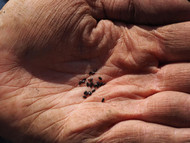How to sow wildflower seed
Sowing wildflower seeds can seem like a daunting task, but it can be a simple process if carried out correctly. We have prepared this advice page to help you prepare and sow your wildflower seed with no issues this year, so be sure to read on if you want a beautiful blooming wildflower meadow in your project!
Preparation
When sowing wildflower seed, the first thing you need to consider is ensuring that your seed bed has been treated and is clean to allow for the most effective results. You can start by removing any existing vegetation, followed by a light rotovation. We recommend that you do not rotovate any deeper than 2-3 inches, as anything deeper may result in you churning up dormant “weed” seeds that will then take over the seed bed.
Starting with a clean seed bed is key, so if there are existing seeds in your chosen area it is important to allow them to germinate and begin to grow before being removed by your chosen method. This process may need to be carried out up to three times to ensure ideal preparation of your final seed bed which will then be ready for sowing after a light raking.
Sowing
Following recommended sowing rates is another important factor to consider, as exceeding these sowing rates won’t give you more flowers or better plants, and in some cases can actually hinder the progress of your wildflower meadow. The following sowing rates are generally applicable for most wildflower species:
- 100% Wildflower seed mixes – 2g/m²
- 80/20 Grass/Wildflower seed mixes – 5g/m²
As previously mentioned, exceeding these sowing rates could be harmful, but “bulking out” your mix with a dry substrate or carrier material such as fine, dry sand or sawdust is actually encouraged. This process will make evenly distributing your seed easier, and will also make it easier for you to spot where you have sown. The mix can then be passed through spreading machinery or spread by hand on your chosen area, and for effective establishment it is beneficial to lightly press down on the sown area either by foot or through the use of machinery depending on the size and type of area. To ensure the seed doesn’t dry out, we recommend watering the sown area regularly for a few weeks after sowing, especially if you are not experiencing any rain at that time.
Optimum Sowing Periods
Softer shelled species – March, April May.
Harder shelled species – August, September, October
We recommend sowing in either Spring or Autumn, but it can be carried out any time between March – October. It is important however to consider the species that you are sowing, as some species may have differing optimum sowing periods compared to others. Autumn sowing is more tailored towards species with a harder shell such as XXXX, as it allows their shell to be slowly softened through the regular Autumn/Winter pattern of freezing and defrosting. This process promotes germination across a broader range of species when Spring comes around.
Spring sowing is also encouraged, however it is worth considering that if you sow a harder shelled seed species in Spring, it will lay dormant until Winter, and will then go through the above mentioned process ready for germination in the following Spring. In general, an Autumn sowing is recommended as it often provides more effective establishment results in the first 12-18 months after sowing.
If you require any further assistance or have any queries regarding establishing a wildflower meadow, be sure to contact our team on email at sales@gardenersupplies.co.uk and we will be happy to help.

